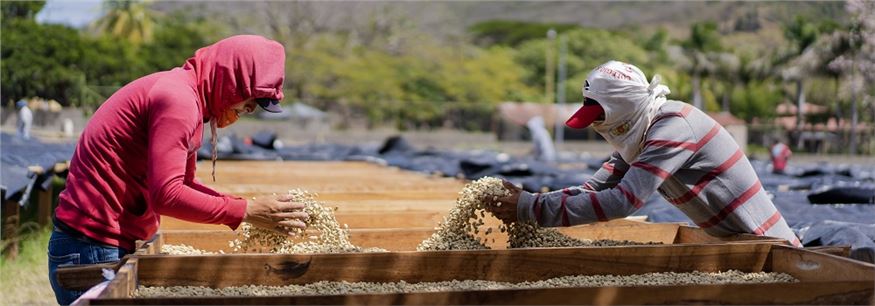Nicaragua Origin Update

In February, our Key Account & Trading Manager Alex Capurro took a trip to Nicaragua (with a few customers in tow) to source some amazing specialties and find out what’s new at the origin.
After over 30 hours’ journey (and what was probably the longest ever Valentine’s day, for the romantics out there), we finally touched down late at night in Managua, the capital city of Nicaragua. This was my first time in the Central American country, so I was quite excited to be there for a brief, four-day visit before heading north to the next stop on our tour: Guatemala. And so, after some Subway for dinner (quite literally the only food available by the time we arrived at the hotel), and a couple of sips of the delicious locally-produced Flor de Caña rum (to help with jetlag of course), it was off to bed for us.
Our journey would take us to the main coffee-producing regions of Matagalpa and Jinotega (a short 2 to 3-hour drive from Managua), which neighbour each other and together are responsible for roughly 90% of coffee production in Nicaragua. The remaining 10% is produced in the Nueva Segovia region, near the Honduran border.
Early the next morning, we were picked up at the hotel by the lovely folks from Sajonia Estates, who drove us to their dry mill near Sebaco, about three quarters of the way from Managua to Matagalpa. A particular characteristic of the Nicaraguan coffee business is that due to high humidity in the producing areas, farmers are generally unable to dry their parchment coffee at their own facilities. As a result, most producers sell wet parchment to exporters who then dry the coffee at their own plants. Sebaco is located in a large basin where dry, hot air is constantly flowing. These conditions make the region an ideal one for drying coffee and is therefore why Sajonia (along with most coffee exporters in Nicaragua) have strategically located their drying patios and dry milling facilities in and around this town.

Sajonia dry mill, Sebaco, Nicaragua
Our visit with Sajonia was an exploratory one, so we were interested to see they offer two main product lines. The first is Fincas (aka single estates), which encompass 13 large farms with an average size of 120 hectares each. Apart from high quality single estate blenders, these estates are also capable of producing some exceptional single varietal and process-driven microlots. Then there is Campesinos (aka small farmers), and coffees are sourced from a total 376 small farmers, 10-14 hectares each on average, and are grouped and marketed as regional coffees. Sajonia helps channel microcredit funds and technical assistance from NGOs and government organisations to small coffee farmers, in order to help them produce the best possible coffee and generate a better financial result than they otherwise would have without this assistance. Suffice to say, it was an extremely interesting (and all too brief) introduction to what Sajonia’s operation is all about, which saw us make some very good new friends.
The next day saw us leave for the Jinotega region, now accompanied by our good friends Stefano and Eduardo from Exportadora Atlantic (part of the extended Ecom family), on our way to visit La Bastilla estate, 20km away from Jinotega city and right next to the Datanli El Diablo nature reserve. The farm is 340 hectares in size, of which 200 are in coffee (the rest being natural forest), and has an altitude range of 1000 to 1450 masl, which is a typical altitude range for the Jinotega/Matagalpa region. Regarding the coffee itself, it is shade grown for the most part, and the farm has segregated its coffee by varietals, which include H1, H3, Marsellesa, Red and Yellow Catuai, as well as Geishas, among others. We were very privileged to cup the whole range across a number of processes including the exceptional Blueberry Candy (natural) and Pineapple Candy (yeast fermentation), both of which will be gracing our shores later on in the year. We are very excited.

New growth at Finca La Bastilla, Jinotega, Nicaragua
The farm also has some impressive infrastructure, including a fully operational wet mill with mechanical drying facilities. They also fund an agricultural technical school which is located on the farm itself, which provide locals with up-to-date information on best farming practices. Last, but certainly not least, was the eco-lodge that La Bastilla runs on the farm as part of promoting coffee tourism in Nicaragua. With rooms overlooking stunning views of the valley sunset, we were duly impressed and grateful to be spending the night there in such an impressive setting.
The following day, after a traditional breakfast of eggs, beans and tortillas, accompanied by copious amounts of La Bastilla coffee, we set out back in the direction of Matagalpa arriving at Finca La Cumplida, a farm which is owned and run by Exportadora Atlantic. This farm is quite famous in the region as it is the home of Marsellesa, a variety of coffee developed by Ecom over two decades ago as a rust-resistant varietal, and which was then propagated via Finca La Cumplida’s nursery. It now plays a very important role in Nicaragua’s coffee production, and has recently spawned a couple new variations that are just now hitting the market, called Mariana and Star Maya.

Coffee Plant Nursery, Finca La Cumplida, Matagalpa, Nicaragua
The nursery operation was something to behold. We were given a comprehensive tour by its manager, agronomist Anderson Palacios. When he started working at La Cumplida 9 years ago, it was a very different set up. Back then they were only producing between 100,000 to 200,000 plants per year, and these days they are producing up to 1.2-1.8 million for the internal market alone, plus another 3 million for export to regional clients such as Costa Rica, El Salvador and Panama. To achieve this, they have an army of 100 local women who expertly graft 500 plants per day (each!) onto robusta rootstock, which helps imbue the seedlings with extra resistance to soil pests such as nematodes. Along with the coffee seedlings, La Cumplida also sells timber seedlings as part of the package, in order for farmers to have shade trees, and an extra revenue stream down the line, thus diversifying their income.
On our final full day in Nicaragua, we were taken to Atlantic’s dry milling facility in Sebaco. As Nicaragua’s second-largest exporter, Atlantic’s whole operation was as impressive as one would expect. Their QA department, run by Elias Garcia, cups over 300 patio lots per day at the peak of the season, which equates to 1500+ individual cups per day! The drying patios themselves cover 36 hectares, and are accompanied by a substantial mechanical drying capability which can act as a backup during the slow times, or as a substitute when the patios are maxed out. From start to finish, this was a well-oiled machine.
And that was it. Four jam-packed days in which we got a quick overview of our origin partners’ operations quickly came to an end. We caught up with old friends, made some new ones, and wished we could stay for longer… but now it was time to pack our bags, and make our way to our next destination: Guatemala! But that’s a story for another day...


